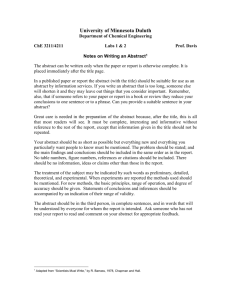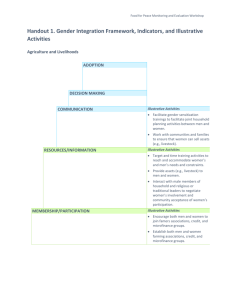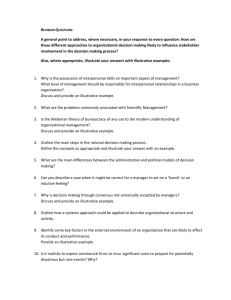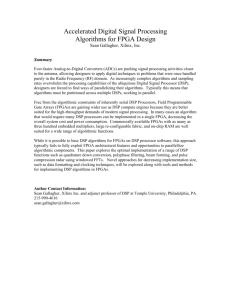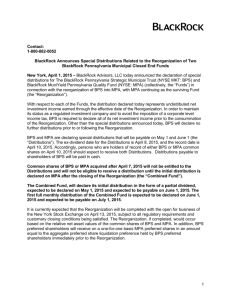Understanding returns and concepts of time value
advertisement
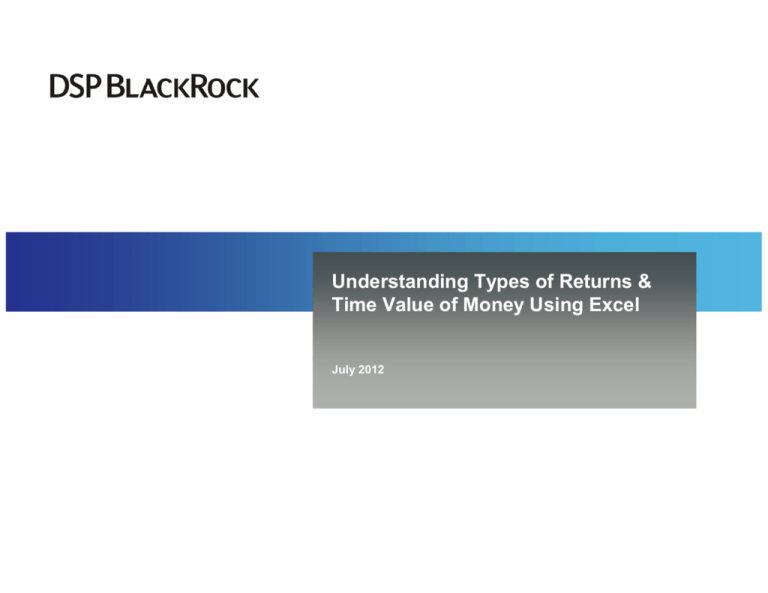
Understanding Types of Returns & Time Value of Money Using Excel July 2012 Annualized Returns Annualized Return – It is a method of arriving at a comparable one-year return (annual return) for investments made for a period of time other than a year Computing Annualized Return Sachin has invested in mutual funds over a period of time. He decides to sell off his investment on 31-Dec-2010; on that day the value of his investment is as shown below: Date Purchase Cost Market Value as on 31-Dec 2010 10-Dec-07 6000 8000 10-Apr-08 10000 12000 18-Jun-09 20000 19000 What is the annualized rate of return on his investment? All figures mentioned in this presentation are for illustrative purpose, these figures does not indicates performance of scheme of DSP BlackRock Mutual Fund 2 Computing Annualized Return Date Purchase cost Market Value Return Absolute Return Date of sale Holding period in days Annualized Return A B C D E F G H C-B D/B*100 F-A E*(365/G) 10-Dec-07 6000 8000 2000 33.33% 31-Dec-10 1117 10.89% 10-Apr-08 10000 12000 2000 20.00% 31-Dec-10 995 7.34% 18-Jun-09 20000 19000 -1000 -5.00% 31-Dec-10 561 -3.25% To annualize, we multiply the absolute rate of return by a factor such as: • 365/number of days the investment was held • 12/number of months the investment was held • 1/number of years the investment was held All figures mentioned in this presentation are for illustrative purpose, these figures does not indicates performance of scheme of DSP BlackRock Mutual Fund 3 Yield or Return on Investment It refers to the interest or dividends received from a security and is usually expressed annually as a percentage based on its market value/purchase price. Computing Dividend Yield An equity share was bought for Rs 150. A dividend of 20% was declared on the face value of Rs 10 per share. What is the return to the investor? Face Value 10 Dividend on the equity Share 20% Dividend on the equity Share (10*20%) Purchase Price of equity share 2 150 Dividend Earned 2 Dividend yield or return on investment (2/150)*100 1.33% All figures mentioned in this presentation are for illustrative purpose, these figures does not indicates performance of scheme of DSP BlackRock Mutual Fund 4 Total Return Return can be earned both in the form of dividends and gain/loss on sale of investment. Total return captures the return generated by an asset both from capital appreciation/loss and interest/dividend earned, if any. Computing Total Return Sunil bought an equity share whose face value is Rs 10 for Rs 200 and earned 30% dividend in year 1, 40% dividend in year 2, and sold it off after three years for Rs 250. what is his return on investment? Face Value 10 Year 1 dividend 30% i.e. 30% of Rs 10 3 Year 2 dividend 40% i.e. 40%*10 4 Purchase Price 200 Sold at 250 Profit from selling 50 Total return ( 3+4+50) 57 The rate of return percent per annum(57/200)*1/3*100 9.50% Annualized return :1/number of years the investment was held All figures mentioned in this presentation are for illustrative purpose, these figures does not indicates performance of scheme of DSP BlackRock Mutual Fund 5 Compounded Annual Growth Rate Compound Annual Growth Rate (CAGR) - The year-over-year growth rate of an investment over a specified period of time. Compounded return takes time value into account. It is an accepted standard for calculating returns for any period greater than a year. Assume that Rs 10,000 was invested in a mutual fund on 1st Jan 2010 and redeemed at Rs 13,000 on 1st Jan 2012 i.e. at the end of 2 years. What is the compounded rate of return? We could say that Rs 10,000 grew at some compounded rate to become Rs 13,000 at the end of 2 years. 10000*(1+R)2 = 13000 R = (13000/10000)(1/2) - 1 = 14.02% The above calculation may look very complicated, but we can use Microsoft Excel to do this in a very simple manner using XIRR function All figures mentioned in this presentation are for illustrative purpose, these figures does not indicates performance of scheme of DSP BlackRock Mutual Fund 6 XIRR XIRR is used for computing CAGR for multiple cash flows. It calculates the internal rate of return of an investment where cash flows may or may not be periodic in nature. Let’s consider the previous example Table 1 • Open MS excel and key in the data as shown in table 1. On 1st Jan 2010 there is an outflow of Rs 10,000 hence it is shown as –ve and on 1st Jan 2012 the investment was redeemed, hence there is an inflow of Rs 13,000. • Go to Insert and select function option and select category as Financial Ignore the guess field. You don’t have to key in anything there Note: The date field is mandatory for XIRR calculations All figures mentioned in this presentation are for illustrative purpose, these figures does not indicates performance of scheme of DSP BlackRock Mutual Fund 7 Computing XIRR Computing XIRR Anil buys an equity share on 18th Jan 2007 for Rs 200. He received a dividend of Rs 10 on 31st March 2008; Rs 8 on 2nd April 2009; Rs 12 on 31st March 2010; Rs 10 on 5th April 2011. He sells the share on 5th Jan 2012 at Rs 275.What is the CAGR of his investment? Date Cash Flow 18-Jan-07 -200 31-Mar-08 10 02-Apr-09 8 31-Mar-10 12 05-Apr-11 10 05-Jan-12 275 XIRR 10.26% All figures mentioned in this presentation are for illustrative purpose, these figures does not indicates performance of scheme of DSP BlackRock Mutual Fund 8 Internal Rate of Return (IRR) IRR calculates the internal rate of return where cash flows are periodic in nature. Computing IRR An investor has book an under construction property worth 50 lacs with an initial payment of Rs 10 lacs. The remaining 40 Lacs has to be paid in 4 installments of Rs 10 lacs each for the next 4 years. At the end of the 5th year the investor sold it at Rs 75 lacs. The cash flows are mentioned below. Calculate the return on investment. Dates Investment 01-Jan-2007 (1,000,000) 01-Jan-2008 (1,000,000) 01-Jan-2009 (1,000,000) 01-Jan-2010 (1,000,000) 01-Jan-2011 (1,000,000) 01-Jan-2012 7,500,000 IRR 13.83% IRR is used when there is a periodic cash flow. Hence in the formula only the “values” are considered as the cash flows are periodic. All figures mentioned in this presentation are for illustrative purpose, these figures does not indicates performance of scheme of DSP BlackRock Mutual Fund 9 Weighted Average Portfolio Return The expected return on a portfolio is the sum of weighted average of the expected return on individual securities in the portfolio. Computing expected return on portfolio Asset Class Expected Rate Investment Amount Weight Expected Return of Portfolio A B C E= (A*C) Equity MF 15% 270,000 0.23 3.49% ELSS 15% 100,000 0.09 1.29% Stocks 15% 200,000 0.17 2.59% Liquid Funds 5% 300,000 0.26 1.29% Bonds 7% 180,000 0.16 1.09% Bank FD 7% 50,000 0.04 0.30% Gold 10% 60,000 0.05 0.52% 1.00 10.57% Total 1,160,000 Expected return of the portfolio is 10.57% All figures mentioned in this presentation are for illustrative purpose, these figures does not indicates performance of scheme of DSP BlackRock Mutual Fund 10 Understanding Time Value of Money through excel Let’ understand few important terms used in excel. FV: It is the future value, or a cash balance you want to have after the last payment is made. Rate is the interest rate per period. Interest is normally given per annum. If it is quarterly we need to use rate percent/4 Nper: It is the total number of payment period in the investment Pmt: It is the payment made in each period. It cannot change over the life of the investment. PV: It is the present value, or the lump-sum amount that a series of payment is worth now Type: Type is a value representing the timing of payment; payment at the beginning of the period =1( e.g. SIP, premium); payment at the end of the period =0 ( e.g. EMI of home loan). If you don’t mention any thing then by default it will consider payment made at end of period i.e.0 All figures mentioned in this presentation are for illustrative purpose, these figures does not indicates performance of scheme of DSP BlackRock Mutual Fund 11 Computing Future Value If you invest Rs 5,000 today at a rate of 9% per annum, what will be its future value after 12 yrs? PV 5000 Rate 9% Tenor 12 FV 14,063 Type will play a role only when pmt is involved. In our example we have to ignore it as no payment is involved. If your yearly expenses is Rs 240,000 .How much amount would you require per month, 20 years hence to maintain the same standard of living. Assuming inflation to be 7% p.a PV 240,000 Rate 7% Tenor 20 FV Calculate? All figures mentioned in this presentation are for illustrative purpose, these figures does not indicates performance of scheme of DSP BlackRock Mutual Fund 12 Computing PV What is the present value of Rs 1,000,000 receivable 30 years from now, if the discount rate is 10% FV 1000000 Rate 10% Nper 30 PV (57,309) All figures mentioned in this presentation are for illustrative purpose, these figures does not indicates performance of scheme of DSP BlackRock Mutual Fund 13 Computing payment Sheena is 3 years old. Her father wants to make a provision of Rs 30 lacs for her graduation. He wants the amount when she is 18 yrs old. You advise her father to start a systematic investment plan in a diversified equity mutual fund assuming it would give 12% as annual rate of return. How much should he invest every month? Time to graduate ( yrs) 15 No of month 180 Rate of return per annum 12% FV 3,000,000 PMT (5,946) In SIP the time of the payment is at the beginning of the term, hence “Type” is 1 All figures mentioned in this presentation are for illustrative purpose, these figures does not indicates performance of scheme of DSP BlackRock Mutual Fund 14 Computing payment You have taken a home loan for Rs 3,843,000 for a period of 20 years and rate of interest is 8%. What will be your EMI? PV 3,843,000 Nper 240 Rate of Interest 8% Pmt 32,144 In home loan, EMI starts after 30 days from the date of disbursement of loan. Hence type is “0” signifying the payment is made at the end of the period. All figures mentioned in this presentation are for illustrative purpose, these figures does not indicates performance of scheme of DSP BlackRock Mutual Fund 15 Computing “rate” using excel A finance company advertised that it will pay a lump sum of Rs 44,650 at the end of 5 years to investors who deposit Rs 6000 annually for 5 years. What is the rate implicit in this offer? FV 44650 Pmt -6000 Nper 5 Rate 20% All figures mentioned in this presentation are for illustrative purpose, these figures does not indicates performance of scheme of DSP BlackRock Mutual Fund 16 Snapshot Terms What they mean? Annualized Returns It is a comparable one year return on an investment made for any period, other than a year Yield It is the income generated by an asset divided by the market price of the asset or the purchase price of the asset Total Return It captures the return generated by an asset from both capital appreciation/loss and interest/dividend earned, if any CAGR It is the year-over-year growth rate of an investment for any period greater than a year. XIRR It’s the internal rate of return for a series of cash flows that may or may not be periodic in nature IRR Expected Portfolio Return Time Value of Money It’s the internal rate of return for a series of cash flows that are periodic in nature It is the sum of weighted average of the expected return on individual securities in the portfolio It tells you the present value of future income/payments discounted at a particular rate. It can also be used to compute the future value of cash flows based on a rate of interest. Case Study-1 Mr. Bade Miyan aged 40 and his wife Hina aged 38 are living in Mumbai for the last 10 years. They have 2 children Rohan (7) and Arti (4). Both of them are studying in school. His take home salary is Rs. 45,000 p.m. He has found out that his monthly expense is Rs. 22,000. He pays his home loan EMI every month. He had bought a 2 BHK flat when he came to Mumbai 10 years back. They have taken a home loan of Rs. 6,00,000 for which he pays an EMI of Rs. 5,000. He wants to buy a car worth Rs. 8,00,000 today, at the time of his retirement. His current portfolio comprises of the following: He has a life insurance policy with a sum assured of Rs. 7,00,000. He has sufficient health insurance for his family and himself. He wants to build a retirement corpus and they have a life expectancy of 75 years. Questions 1. He would like to send his children to an overseas university when they reach 21 years of age. He estimates that in today’s value the education fund for one child required is Rs. 8,00,000. He assumes that the inflation rate is 10% and the rate of return on his investment is 12%. Calculate how much education fund is required for the university education when his child reaches 21 years of age. 2. Mr. Bade Miyan purchased a flat of Rs. 15,00,000. He expects the property to appreciate by average rate of 12% p.a. compounded annually. He wants to sell the property for Rs. 20,00,000. How long in years he has to wait before the flat is worth Rs. 20,00,000. 3. Mr. Bade Miyan is planning to retire at the age of 60 years. His life expectancy is 85 years. He wants to have a corpus so as to be able to withdraw Rs. 1,00,000 from the account at the beginning of the year after his retirement till age 85. He also wants to have a corpus of Rs. 20,00,000 left in the account at the time of his expected death. He plans to accumulate the corpus by making annual contributions for the next 20 years. He expects to earn 12% p.a. before his retirement and 8% p.a. post his retirement. He will put his investments in safe instruments. What equal annual deposits should he make each year to reach his retirement goal? Inflation is taken as 5%. All figures mentioned in this presentation are for illustrative purpose, these figures does not indicates performance of scheme of DSP BlackRock Mutual Fund 18 Case Study 2 Mr. Aspiring (35) is into business of textile garments. His family includes his wife (30) & a son (5). Till now he has invested all his business profits into business working capital & purchasing a flat, where he is living. He is now seeking advice to invest his yearly savings of about Rs. 12 Lakhs into various assets other than business, which will enable him to meet his financial goals in life. After understanding his financial goals you have proposed the below investment portfolio Asset Class Annual Investments (Lakh RS.) Expected Rate of return 2.7 15% ELSS 1 15% Stocks 2 15% Liquid Funds 3 5% Bonds 1.8 7% Bank FD 0.5 7% Gold 0.6 10% Medi Claim 0.05 - Life Insurance 0.35 - Equity MF Net Annual Investments 12 Questions 1. If Aspiring invests as per the advised portfolio what will be the average annual returns of the portfolio at the end of the 10th year? (Consider investments of the first year only for this purpose) All figures mentioned in this presentation are for illustrative purpose, these figures does not indicates performance of scheme of DSP BlackRock Mutual Fund Case Study 2 2. Aspiring is considering the following investment projects: Cash Flows Projects C0 C1 C2 C3 1 -10,000 +10,000 NIL NIL 2 -10,000 +7,500 +7,500 NIL 3 -10,000 +2,000 +4,000 +12,000 4 -10,000 +10,000 +3,000 +3,000 Assuming the projects are independent and mutually exclusive, advice Aspiring which project he should opt for on the basis of IRR. All figures mentioned in this presentation are for illustrative purpose, these figures does not indicates performance of scheme of DSP BlackRock Mutual Fund Disclaimer This presentation shall not constitute any offer to sell or solicitation of an offer to buy units of any of the Schemes of the DSP BlackRock Mutual Fund All figures mentioned in this presentation are for illustrative purpose, these figures does not indicates performance of scheme of DSP BlackRock Mutual Fund Mutual Fund investments are subject to market risks, read all scheme related documents carefully.
